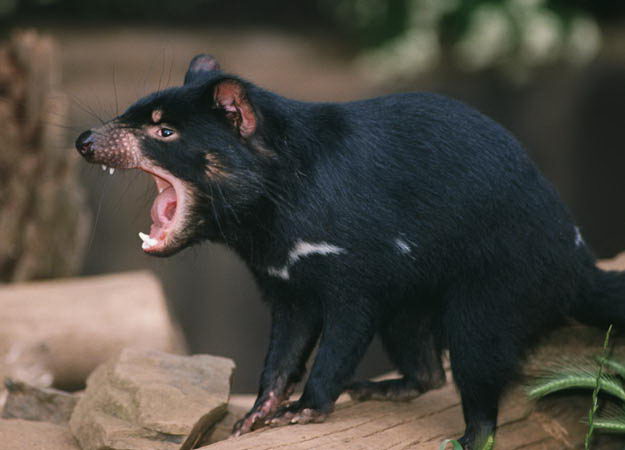Learn all about Tasmanian Devil now with these amazing Tasmanian Devil Facts For Kids. Tasmanian devil is the world’s largest carnivore marsupial. As the name indicates, the species is native to the Australian state, Tasmania. It is likely to go extinct in the near future as its future is threatened in the wild. Tasmanian devil is almost the size of a small dog and is completely black or sometimes dark brown. The Devil lives in an island which is why it has adapted some of its unique characteristics—not seen in other animals. They fancy living in scrublands and farmlands.
Tasmanian Devil Facts For Kids
Characteristics and Features
- Tasmanian Devil had become the largest carnivore marsupial after the extinction of Tasmanian wolf (thylacine) in 1936.
- It looks like a small bear with the length measuring 20.5 to 30.5 inches (53 – 80 cm). Tasmanian devil has 9 – 12 inches (23 – 30 cm) long tail.
- The weight of these small marsupials is 11 – 26 pounds (9 – 12 inches).
- They have strong teeth and powerful muscles. Tasmanian Devils can easily crush bones with their teeth. They have a heavy short body.
- Tasmanian devils have large ears and small eyes.
- The devil was once thought to exist in large numbers in the mainland of Australia. Geologists believe that Dingo might be responsible for the endangerment of Tasmanian devils.
Read More: Tasmanian Devil Facts

- Tasmanian devil is highly nocturnal species. It spends most of its daytime under the shelter in woodlands or in rocky places.
- They make their habitats in hollow logs, caves, or even in tree roots. Tasmanian devils come out only at night.
- They are not perfectly adapted to tree climbing though they often run up the trunks or tree branches.
- It is because of its wild nature that geologists call it a ‘Devil’. However, it may not attack humans.
- They have a growling voice and a snarling cough or a low yell.
- Like kangaroos or wallabies, Tasmanian devils have pouch to carry their young.
Feeding, Diet and Ecology
- Tasmanian devil is a poor hunter but an expert scavenger. It usually feeds on dead flesh because the devil is unable to pull down or hunt active prey.
- The devils fancy killing small animals such as rat kangaroos, Bennet’s wallaby, birds, lizards, and wombats.
- At times devils also chase down hen roosts and sheepfolds but this is not their regular hunt.
- They are capable to chew down and digest even the hardest part of the prey—bones. They crush the bones with their powerful jaws.
Read More: What Do Tasmanian Devils Eat?
Reproductive Biology
Tasmanian devils have unique breeding habits. Although male and female get together in the month of March but they start breeding only after 2 weeks.
- During these two weeks, male keeps an eye on a female all the time.
- The female gives birth to 2 to 4 live young in the month of either late May or early June. These babies remain in the mother’s pouch safe and sound.
- The babies are 1.25 cm long at birth but they will reach the length of 2.5 inches (7 cm) in about 7 weeks.
- Unlike most marsupials, Tasmanian devils have enclosed pouches.
- The baby opens its eyes after a period of 15 weeks. The baby’s coat grows after 15 weeks.
- The baby usually grows its tail in the month of September and its feet are also seen out of the pouch. When babies are able to come out of the pouch, the mother and father make a soft grass bed in a tree trunk or hollow or sometimes in wombat’s abandoned burrow.
- The offspring weans after they reach 5 months. They become mature in their second year.
- The gestation period is about 31 days with a one year breeding interval.
- Females litter single baby in a year because it takes her too much effort to raise the young.
- The average lifespan of Tasmanian devils is 7 – 8 years, perhaps longer.
Read More: Tasmanian Devil Predators
Conservation
- These devils live in a fairly small island of Australia, Tasmania. The island covers only 25,000 sq. miles (65,000 sq. kilometers).
- The island was quite clean till the late 18th century and there were no significant human settlement that could disturb the flora or fauna.
- However, the start of the 19th century was not a good period as it introduced many non-native species and humans also began moving towards the island.
- In addition, the agricultural development also badly hit the devil’s habitat as they were forced to leave their natural habitats.
- It was the same destruction of forests that led to the extinction of Tasmanian wolf in 1930s. If the conservation measurements are not taken immediately then perhaps the future of devils would be at stake.
Read More: Why are Tasmanian Devils Endangered?






Leave a Reply